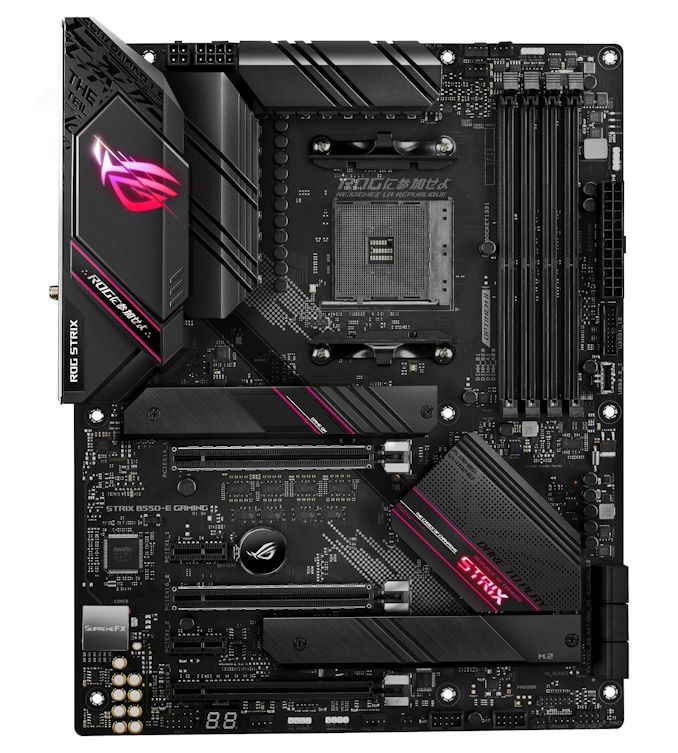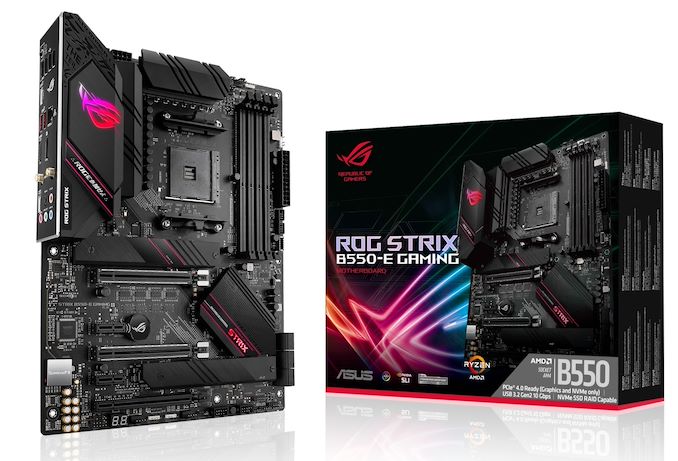The AMD B550 Motherboard Overview: ASUS, GIGABYTE, MSI, ASRock, and Others
by Dr. Ian Cutress & Gavin Bonshor on June 16, 2020 11:00 AM ESTASUS ROG Strix B550-E Gaming
Out of ASUS’ three main sub-brands for B550, the Strix is aimed at the higher end, and we get a range of options to play with. The B550-E Gaming is the more expensive of the bunch, at $280, although it is one of the few boards to offer x8/x8 functionality with its PCIe slots. The use of this configuration isn’t so much for gaming (despite the name), due to lack of SLI support, but it does enable a good setup for a machine based around GPU compute or add-in cards, like RAID cards, or additional PCIe x4 NVMe drives.
ASUS’ design philosophy this time around involves a similar corner to corner 45-degree line scheme to a lot of other different brands, however in parts ASUS pushes this to a more dot-matrix style design. We still get that ROG font on all the words though.
For features, the B550-E Gaming has a large rear panel cover that covers only the rear panel rather than the full audio section, and this covers over the heatsink for the power delivery. There are two heatsinks here, like most boards with high-end power delivery, but there does not seem to be a heatpipe between them for this board.
The socket area has access to four 4-pin fan headers within easy reach, three of which are just above and to the right of the socket. The CPU is powered by an 8-pin and a 4-pin, and the board has four memory slots with single sided latch arrangements. Down the right hand side of the board is a 4-pin LED header, a 24-pin ATX power connector, a USB 3.0 header, a Type-C header, and six SATA ports.
For the PCIe area, as mentioned the two main PCIe slots both come from the CPU, with x16 or x8/x8 connectivity at PCIe 4.0 bandwidth, due to the use of PCIe switches. Both of the main PCIe slots have extra reinforcement, and above the first PCIe slot is a PCIe 4.0 x4 M.2 slot, with its own heatsink. This isn’t connected directly to the chipset heatsink, however the second M.2 slot (a PCIe 3.0 x4 from the chipset) is connected. The final full-length PCIe slot is a PCIe 3.0 x4 from the chipset as well.
Along the bottom of the board is a 2-digit debug, two 4-pin fan headers, two RGB LED headers, two USB 2.0 headers, and the front panel headers. The audio codec on the left, ASUS’ custom S1200A codec, gets the SupremeFX treatment.
On the rear panel there is a 2.5 gigabit Ethernet port (Intel I225-V), a DisplayPort, a HDMI video output, two Type-A USB 3.2 Gen 2 ports, one Type-C USB 3.2 Gen 2 port, four USB 2.0 ports, one USB 2.0 Type-C port for audio, audio jacks, a BIOS Flashback button, and an Intel AX200 Wi-Fi 6 module.













101 Comments
View All Comments
Lucky Stripes 99 - Tuesday, June 16, 2020 - link
I've read elsewhere that Zen1 processors supposedly had a 128 Mb address limit for UEFI firmware. It sounds suspect, but looking back at early AM4 boards, I don't recall any with either 256 Mb chips or striped 128 Mb chips, so maybe it wasn't simply due to the significant jump in price for 256 Mb chips over 128 Mb ones.Redstorm - Tuesday, June 16, 2020 - link
Likewise, looking to replace my aging 7 year old HTPC with a mATX B550 and a Ryzen 4700G but radio silence from AMD on releasing compatiable APU's for the B550's, We now have the long overdue Budget motherboards but no APU's. Dissapointed.alufan - Wednesday, June 17, 2020 - link
I understand the frustration however if your buying a Budget Board then surely a budget CPU is the best fit, also new APUs are inbound according to all the rumours, meanwhile your older APU will fit just fine I believe, I expect the new APUs will have Navi cores as per the Xbox and PS5 but of course they probably cannot be released until the new Navi cards and consoles are out, think about it though what a sea chamge folks are now waiting eagerly for a new release from AMD because they know it will kick ass not close the gap to Intel, its a good time to be a customer!Gigaplex - Wednesday, June 17, 2020 - link
Older APUs aren't supported on B550DigitalFreak - Tuesday, June 16, 2020 - link
I think you forgot something... :-)Fortunately, this component is a unique motherboard among B550 and well worth reading up on [add link].
DigitalFreak - Tuesday, June 16, 2020 - link
Interesting that the GIGABYTE B550 Vision D board's Type-C ports don't have the Thunderbolt logo next to them. I wonder if Intel won't all the logo to be use on AMD systems.DigitalFreak - Tuesday, June 16, 2020 - link
*allowDigitalFreak - Tuesday, June 16, 2020 - link
"Although on paper, there isn't much difference between B450 and B550 with slightly more SATA available due to the removable of eSATA support, both remain PCIe 3.0 bound."The B450 only had PCIe 2.0 lanes. Huge difference from the B550 IMO
Lucky Stripes 99 - Tuesday, June 16, 2020 - link
Agreed. That's going to make a huge difference for boards with secondary or tertiary M.2 or U.2 ports that hangs off the chipset. That goes double if they only get 2 PCIe lanes instead of the full 4.a5cent - Friday, June 19, 2020 - link
Yup, exactly what I thought.Equally "BIG" is that B550 finally has more PCIe lanes, so adding more NVMe drives doesn't require downgrading other ports like it always did on B450.
B450 was a firmware upgrade for the budget B350 chipset. B550 is the first time this tier of AMD chipset doesn't suck.